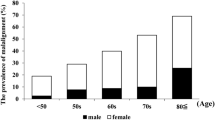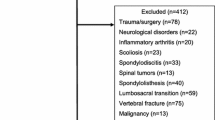Abstract
Objective
The objective of this research was to evaluate the prevalence of cervical and lumbar pain in obese patients eligible for bariatric surgery and to investigate possible changes in sagittal spine alignment in these patients.
Methods
The following parameters were compared in 30 obese patients and a control group of 25 non-obese volunteers: body mass index, prevalence of cervical and lumbar pain assessed by visual analog scale (VAS), Neck Disability Index [NDI] and Oswestry Disability Index [ODI], as well as radiographic parameters of the spine and pelvis measured with Surgimap software.
Results
The cervical and lumbar VAS and the NDI and ODI were significantly worse in obese patients. Compared with the control group, the cervical sagittal vertical axis (cSVA) of the obese group had higher variance (p value = 0.0025) and the cervical lordosis was diminished (p value = 0.0023). Thoracic kyphosis, lumbar lordosis, and the pelvic parameters were not significantly different between the groups.
Conclusions
Obese patients demonstrated lower functional performance compared with their non-obese counterparts, while cervical lordosis was diminished and the cSVA was increased in obese patients.
Graphical abstract
These slides can be retrieved under Electronic Supplementary Material.






Similar content being viewed by others
References
Kushner RF, Kahan S (2018) Introduction: the state of obesity in 2017. Med Clin North Am 102:1–11. https://doi.org/10.1016/j.mcna.2017.08.003
World Health Organization, WHO (2018) WHO Obesity and Overweight. In: World Health Organisation http://www.who.int/mediacentre/factsheets/fs311/en/. Accessed 14 Feb 2019
Dobbs R, Sawers C, Thompson F et al (2014) Overcoming obesity: an initial economic analysis. McKinsey Global Institute, New York City
Deere KC, Clinch J, Holliday K et al (2012) Obesity is a risk factor for musculoskeletal pain in adolescents: findings from a population-based cohort. Pain 153:1932–1938. https://doi.org/10.1016/j.pain.2012.06.006
Martins GC, Martins Filho LF, Raposo AH et al (2018) Avaliação radiográfica e de sintomatologia dolorosa do joelho em indivíduos com obesidade grave—estudo controlado transversal. Rev Bras Ortop 53:740–746. https://doi.org/10.1016/j.rbo.2017.06.024
Nilsen TIL, Holtermann A, Mork PJ (2011) Physical exercise, body mass index, and risk of chronic pain in the low back and neck/shoulders: longitudinal data from the Nord-Trøndelag health study. Am J Epidemiol 174:267–273. https://doi.org/10.1093/aje/kwr087
Heuch I, Heuch I, Hagen K, Zwart J-A (2013) Body mass index as a risk factor for developing chronic low back pain: a follow-up in the Nord-Trondelag health study. Spine (Phila Pa 1976) 38:133–139. https://doi.org/10.1097/BRS.0b013e3182647af2
Wearing SC, Hennig EM, Byrne NM et al (2006) Musculoskeletal disorders associated with obesity: a biomechanical perspective. Obes Rev 7:239–250. https://doi.org/10.1111/j.1467-789X.2006.00251.x
Ghezelbash F, Shirazi-Adl A, Plamondon A et al (2017) Obesity and obesity shape markedly influence spine biomechanics: a subject-specific risk assessment model. Ann Biomed Eng 45:2373–2382. https://doi.org/10.1007/s10439-017-1868-7
Gegout PP, Francin PJ, Mainard D, Presle N (2008) Adipokines in osteoarthritis: friends or foes of cartilage homeostasis? Jt Bone Spine 75:669–671. https://doi.org/10.1016/j.jbspin.2008.07.008
Conde J, Scotece M, Gómez R et al (2011) Adipokines: biofactors from white adipose tissue. A complex hub among inflammation, metabolism, and immunity. BioFactors 37:413–420. https://doi.org/10.1002/biof.185
Thijssen E, van Caam A, van der Kraan PM (2015) Obesity and osteoarthritis, more than just wear and tear: pivotal roles for inflamed adipose tissue and dyslipidaemia in obesity-induced osteoarthritis. Rheumatology 54:588–600. https://doi.org/10.1093/rheumatology/keu464
Segar AH, Fairbank JCT, Urban J (2018) Leptin and the intervertebral disc: a biochemical link exists between obesity, intervertebral disc degeneration and low back pain—an in vitro study in a bovine model. Eur Spine J. https://doi.org/10.1007/s00586-018-5778-7
Terashima Y, Kakutani K, Yurube T et al (2016) Expression of adiponectin receptors in human and rat intervertebral disc cells and changes in receptor expression during disc degeneration using a rat tail temporary static compression model. J Orthop Surg Res 11:147. https://doi.org/10.1186/s13018-016-0481-z
Goettler A, Grosse A, Sonntag D (2017) Productivity loss due to overweight and obesity: a systematic review of indirect costs. BMJ Open 7:e014632. https://doi.org/10.1136/bmjopen-2016-014632
Di Cesare M, Bentham J, Stevens GA et al (2016) Trends in adult body-mass index in 200 countries from 1975 to 2014: a pooled analysis of 1698 population-based measurement studies with 19.2 million participants. Lancet 387:1377–1396. https://doi.org/10.1016/S0140-6736(16)30054-X
Buchbinder R, Blyth FM, March LM et al (2013) Placing the global burden of low back pain in context. Best Pract Res Clin Rheumatol 27:575–589. https://doi.org/10.1016/j.berh.2013.10.007
Hoy D, March L, Brooks P et al (2010) Measuring the global burden of low back pain. Best Pract Res Clin Rheumatol 24:155–165
Wynne-Jones G, Cowen J, Jordan JL et al (2014) Absence from work and return to work in people with back pain: a systematic review and meta-analysis. Occup Environ Med 71:448–456. https://doi.org/10.1136/oemed-2013-101571
Manchikanti L, Singh V, Datta S et al (2009) Comprehensive review of epidemiology, scope, and impact of spinal pain. Pain Physician 12:E35–E70
Araújo F, Lucas R, Alegrete N et al (2014) Individual and contextual characteristics as determinants of sagittal standing posture: a population-based study of adults. Spine J 14:2373–2383. https://doi.org/10.1016/j.spinee.2014.01.040
Dario AB, Loureiro Ferreira M, Refshauge K et al (2017) Obesity does not increase the risk of chronic low back pain when genetics are considered. A prospective study of Spanish adult twins. Spine J 17:282–290. https://doi.org/10.1016/j.spinee.2016.10.006
Lake JK, Power C, Cole TJ (2000) Back pain and obesity in the 1958 British birth cohort: cause or effect? J Clin Epidemiol 53:245–250. https://doi.org/10.1016/S0895-4356(99)00155-9
Chaléat-Valayer E, Mac-Thiong J-M, Paquet J et al (2011) Sagittal spino-pelvic alignment in chronic low back pain. Eur Spine J 20:634–640. https://doi.org/10.1007/s00586-011-1931-2
Chun S-W, Lim C-Y, Kim K et al (2017) The relationships between low back pain and lumbar lordosis: a systematic review and meta-analysis. Spine J 17:1180–1191. https://doi.org/10.1016/j.spinee.2017.04.034
Vismara L, Menegoni F, Zaina F et al (2010) Effect of obesity and low back pain on spinal mobility: a cross sectional study in women. J Neuroeng Rehabil 7:3. https://doi.org/10.1186/1743-0003-7-3
Chanplakorn P, Sa-ngasoongsong P, Wongsak S et al (2012) The correlation between the sagittal lumbopelvic alignments in standing position and the risk factors influencing low back pain. Orthop Rev (Pavia) 3:11. https://doi.org/10.4081/or.2012.e11
World Health Organization (WHO) (2000) Obesity: preventing and managing the global epidemic. Report of a WHO consultation, Switzerland
Vernon H (2008) The neck disability index: state-of-the-art, 1991–2008. J Manip Physiol Ther 31:491–502. https://doi.org/10.1016/j.jmpt.2008.08.006
Fairbank JC, Pynsent PB (2000) The Oswestry disability index. Spine (Phila Pa 1976) 25:2940–2952. https://doi.org/10.1097/00007632-200011150-00017 discussion 2952
Akbar M, Terran J, Ames CP et al (2013) Use of surgimap spine in sagittal plane analysis, osteotomy planning, and correction calculation. Neurosurg Clin N Am 24:163–172
Roussouly P, Gollogly S, Berthonnaud E, Dimnet J (2005) Classification of the normal variation in the sagittal alignment of the human lumbar spine and pelvis in the standing position. Spine (Phila Pa 1976) 30:346–353. https://doi.org/10.1097/01.brs.0000152379.54463.65
Tsuritani I, Honda R, Noborisaka Y et al (2002) Impact of obesity on musculoskeletal pain and difficulty of daily movements in Japanese middle-aged women. Maturitas 42:23–30. https://doi.org/10.1016/S0378-5122(02)00025-7
González-Sánchez M, Luo J, Lee R, Cuesta-Vargas AI (2014) Spine curvature analysis between participants with obesity and normal weight participants: a biplanar electromagnetic device measurement. Biomed Res Int. https://doi.org/10.1155/2014/935151
Leboeuf-Yde C (2000) Body weight and low back pain. A systematic literature review of 56 journal articles reporting on 65 epidemiologic studies. Spine (Phila Pa 1976) 25:226–237. https://doi.org/10.1097/00007632-200001150-00015
Segar AH, Urban JPG, Fairbank JCT, Judge A (2016) The association between body mass index (BMI) and back or leg pain in patients with spinal conditions. Spine (Phila Pa 1976) 41:E1237–E1243. https://doi.org/10.1097/BRS.0000000000001606
Brooks C, Siegler JC, Cheema BS, Marshall PWM (2013) No relationship between body mass index and changes in pain and disability after exercise rehabilitation for patients with mild to moderate chronic low back pain. Spine (Phila Pa 1976) 38:2190–2195. https://doi.org/10.1097/BRS.0000000000000002
Heuch I, Heuch I, Hagen K, Zwart J-A (2015) A Comparison of anthropometric measures for assessing the association between body size and risk of chronic low back pain: the HUNT study. PLoS One 10:e0141268. https://doi.org/10.1371/journal.pone.0141268
Tang JA, Scheer JK, Smith JS et al (2012) The impact of standing regional cervical sagittal alignment on outcomes in posterior cervical fusion surgery. Neurosurgery 71:662–669. https://doi.org/10.1227/NEU.0b013e31826100c9
Boulay C, Tardieu C, Hecquet J et al (2006) Sagittal alignment of spine and pelvis regulated by pelvic incidence: standard values and prediction of lordosis. Eur Spine J 15:415–422. https://doi.org/10.1007/s00586-005-0984-5
Bao H, Lafage R, Liabaud B et al (2018) Three types of sagittal alignment regarding compensation in asymptomatic adults: the contribution of the spine and lower limbs. Eur Spine J 27:397–405. https://doi.org/10.1007/s00586-017-5159-7
Smith JS, Lafage V, Ryan DJ et al (2013) Association of myelopathy scores with cervical sagittal balance and normalized spinal cord volume. Spine (Phila Pa 1976) 38:S161–S170. https://doi.org/10.1097/BRS.0b013e3182a7eb9e
Lee S-H, Son E-S, Seo E-M et al (2015) Factors determining cervical spine sagittal balance in asymptomatic adults: correlation with spinopelvic balance and thoracic inlet alignment. Spine J 15:705–712. https://doi.org/10.1016/j.spinee.2013.06.059
Guigui P, Levassor N, Rillardon L et al (2003) Physiological value of pelvic and spinal parameters of sagital balance: analysis of 250 healthy volunteers. Rev Chir Orthop Reparatrice Appar Mot 89:496–506. RCO-10-2003-89-6-0035-1040-101019-ART3
Kulcheski AL, Soler X, Graells BML, Baretta G (2013) Avaliação angular do equilíbrio sagital em pacientes obesos. Coluna/Columna 12:224–227. https://doi.org/10.1590/S1808-18512013000300010
Roussouly P, Pinheiro-Franco JL (2011) Biomechanical analysis of the spino-pelvic organization and adaptation in pathology. Eur Spine J 20:609–618
Romero-Vargas S, Zárate-Kalfópulos B, Otero-Cámara E et al (2013) The impact of body mass index and central obesity on the spino-pelvic parameters: a correlation study. Eur Spine J 22:878–882
National Institutes of Health (1991) Gastrointestinal surgery for severe obesity. In: Consensus statement. National Institutes of Health consensus development conference, pp 1–20
Acknowledgments
We thank Peter Mittwede, MD, PhD, from Edanz Group (www.edanzediting.com/ac) for editing a draft of this manuscript. We thank Isabela Peixoto de Mello for drawing the figure representing the measures.
Funding
The study was performed using personal resources from the authors and exams performed at Hospital Federal de Ipanema as part of the pre-operative evaluation.
Author information
Authors and Affiliations
Contributions
Alexandre Peixoto de Mello and Glaucus Cajaty dos Santos Martins designed the studies, analyzed data and wrote the manuscript. André Raposo Heringer and Raphael Barbosa Gamallo collected the data from the patients. Maurício de Pinho Gama revised the statistics. Luiz Felippe dos Santos Martins Filho, Antônio Vítor de Abreu and Antonio Carlos Pires Carvalho revised the analyzed data and the manuscript.
Corresponding author
Ethics declarations
Conflict of interest
The authors declare that there is no conflict of interest.
Additional information
Publisher's Note
Springer Nature remains neutral with regard to jurisdictional claims in published maps and institutional affiliations.
Electronic supplementary material
Below is the link to the electronic supplementary material.
Rights and permissions
About this article
Cite this article
de Mello, A.P., Martins, G.C.d., Heringer, A.R. et al. Back pain and sagittal spine alignment in obese patients eligible for bariatric surgery. Eur Spine J 28, 967–975 (2019). https://doi.org/10.1007/s00586-019-05935-0
Received:
Revised:
Accepted:
Published:
Issue Date:
DOI: https://doi.org/10.1007/s00586-019-05935-0




